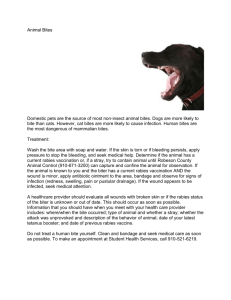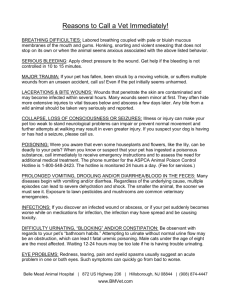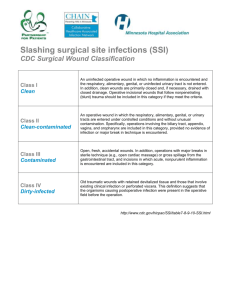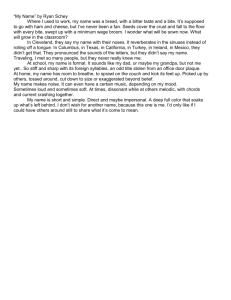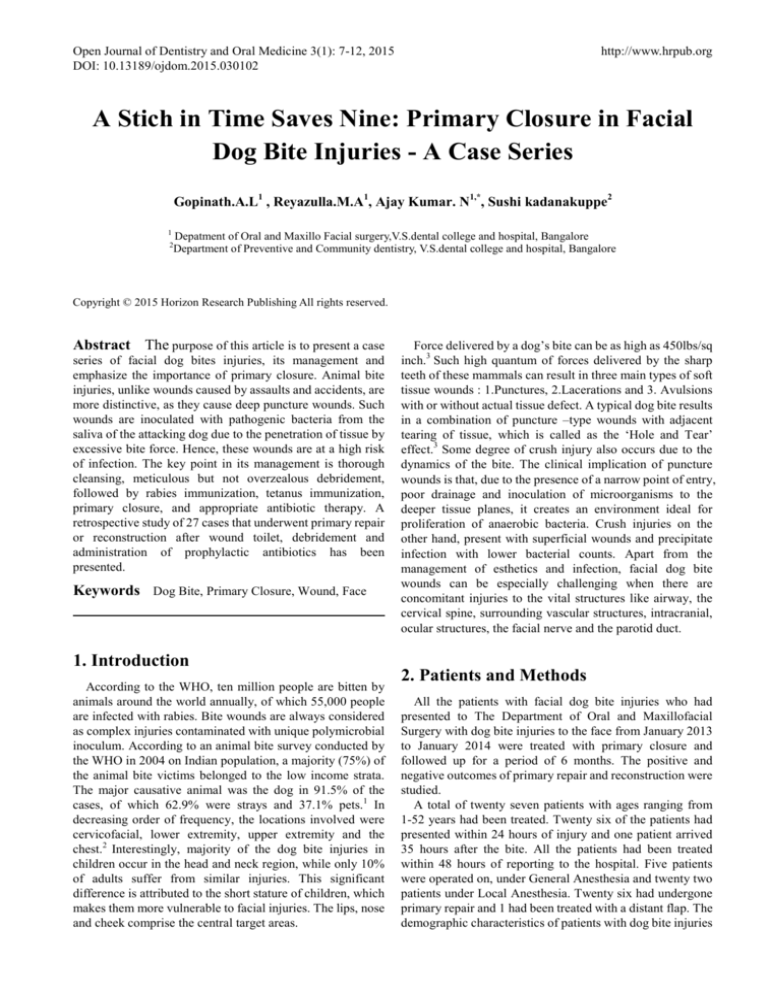
Open Journal of Dentistry and Oral Medicine 3(1): 7-12, 2015
DOI: 10.13189/ojdom.2015.030102
http://www.hrpub.org
A Stich in Time Saves Nine: Primary Closure in Facial
Dog Bite Injuries - A Case Series
Gopinath.A.L1 , Reyazulla.M.A1, Ajay Kumar. N1,*, Sushi kadanakuppe2
1
Depatment of Oral and Maxillo Facial surgery,V.S.dental college and hospital, Bangalore
Department of Preventive and Community dentistry, V.S.dental college and hospital, Bangalore
2
Copyright © 2015 Horizon Research Publishing All rights reserved.
Abstract The purpose of this article is to present a case
series of facial dog bites injuries, its management and
emphasize the importance of primary closure. Animal bite
injuries, unlike wounds caused by assaults and accidents, are
more distinctive, as they cause deep puncture wounds. Such
wounds are inoculated with pathogenic bacteria from the
saliva of the attacking dog due to the penetration of tissue by
excessive bite force. Hence, these wounds are at a high risk
of infection. The key point in its management is thorough
cleansing, meticulous but not overzealous debridement,
followed by rabies immunization, tetanus immunization,
primary closure, and appropriate antibiotic therapy. A
retrospective study of 27 cases that underwent primary repair
or reconstruction after wound toilet, debridement and
administration of prophylactic antibiotics has been
presented.
Keywords Dog Bite, Primary Closure, Wound, Face
1. Introduction
According to the WHO, ten million people are bitten by
animals around the world annually, of which 55,000 people
are infected with rabies. Bite wounds are always considered
as complex injuries contaminated with unique polymicrobial
inoculum. According to an animal bite survey conducted by
the WHO in 2004 on Indian population, a majority (75%) of
the animal bite victims belonged to the low income strata.
The major causative animal was the dog in 91.5% of the
cases, of which 62.9% were strays and 37.1% pets.1 In
decreasing order of frequency, the locations involved were
cervicofacial, lower extremity, upper extremity and the
chest.2 Interestingly, majority of the dog bite injuries in
children occur in the head and neck region, while only 10%
of adults suffer from similar injuries. This significant
difference is attributed to the short stature of children, which
makes them more vulnerable to facial injuries. The lips, nose
and cheek comprise the central target areas.
Force delivered by a dog’s bite can be as high as 450lbs/sq
inch.3 Such high quantum of forces delivered by the sharp
teeth of these mammals can result in three main types of soft
tissue wounds : 1.Punctures, 2.Lacerations and 3. Avulsions
with or without actual tissue defect. A typical dog bite results
in a combination of puncture –type wounds with adjacent
tearing of tissue, which is called as the ‘Hole and Tear’
effect.3 Some degree of crush injury also occurs due to the
dynamics of the bite. The clinical implication of puncture
wounds is that, due to the presence of a narrow point of entry,
poor drainage and inoculation of microorganisms to the
deeper tissue planes, it creates an environment ideal for
proliferation of anaerobic bacteria. Crush injuries on the
other hand, present with superficial wounds and precipitate
infection with lower bacterial counts. Apart from the
management of esthetics and infection, facial dog bite
wounds can be especially challenging when there are
concomitant injuries to the vital structures like airway, the
cervical spine, surrounding vascular structures, intracranial,
ocular structures, the facial nerve and the parotid duct.
2. Patients and Methods
All the patients with facial dog bite injuries who had
presented to The Department of Oral and Maxillofacial
Surgery with dog bite injuries to the face from January 2013
to January 2014 were treated with primary closure and
followed up for a period of 6 months. The positive and
negative outcomes of primary repair and reconstruction were
studied.
A total of twenty seven patients with ages ranging from
1-52 years had been treated. Twenty six of the patients had
presented within 24 hours of injury and one patient arrived
35 hours after the bite. All the patients had been treated
within 48 hours of reporting to the hospital. Five patients
were operated on, under General Anesthesia and twenty two
patients under Local Anesthesia. Twenty six had undergone
primary repair and 1 had been treated with a distant flap. The
demographic characteristics of patients with dog bite injuries
8
A Stich in Time Saves Nine: Primary Closure in Facial Dog Bite Injuries - A Case Series
are given in Table 1. The sites of the injury were varied, with
the lips, cheeks and nose being the most commonly affected.
None of the patients presented with injuries to the adjacent
vital structures. The patients were categorized into various
types based on the following classification given in Table 2
and Figure 1.
Table 1. The Demographic Characteristics Of Patients.
AGE
DESCRIPTION
NUMBER OF
PATIENTS
UPTO 28 DAYS
NEONATE
0
TILL 1 YEAR
INFANCY
1
1-3 YEARS
TODDLER
4
3-6 YEARS
PRE-SCHOOL
4
6-10YEARS
SCHOOL GOING
11
14- 18 YEARS
TEENAGERS
2
>18YEARS
ADULTS
5
Table 2. The Percentage Of Patients According To Classification Of Facial
Bite Injuries.3,4,5
Type
No of
patients
Percentage
of patients
I
10
37.03%
IIA
14
51.85%
02
7.40%
IIIA
01
3.70%
IIIB
0
0
IVA
0
0
IVB
0
0
IIB
Clinical Findings
Superficial injury without muscle
involvement
Deep injury with muscle
involvement
Full-thickness injury of the cheek
or lip with oral mucosal
involvement
(through-and-through wound)
Deep injury with tissue defect
(complete avulsion)
Deep avulsive injury exposing
nasal or auricular cartilage
Deep injury with severed facial
nerve and/or parotid duct
Deep injury with concomitant
bone fracture
All patients had been initially managed with a thorough
wound toilet of saline and betadine followed by a surgical
debridement of crushed wound edges. Primary closure was
then attempted. In patients with substantial tissue loss,
reconstruction was performed with local flaps, mucosal
advancement, split skin grafts or full thickness grafts. For
patients operated under general anesthesia, the hospital stays
ranged from 1 to 3 days. After discharge, the patients were
followed up on an outpatient basis.
2.1. Operative Procedures:
The steps followed in the management of the injuries
included:
Skin preparation and anesthesia
Proper surgical toilet of the wound by irrigation.
Meticulous but not overzealous debridement of
devitalized tissue [Resection of skin tags, Removal
of visible foreign particles]
Primary closure of the wound except in the high risk
cases.
Appropriate antibiotic therapy.
Tetanus and rabies immunization.
Follow-up.
On arrival, all the patients were subjected to general
examination by a pediatrician/physician depending on age of
patient. vitals (pulse. temperature, respiratory rate, blood
pressure) were recorded, examination for other associated
injuries was carried out.
All
patients
were
treated
with
anti-rabies
immunoglobulins (human rabies immunoglobulins) into and
around the wound. Dosage of immunoglobulins was based
on the weight of the patient ( 20 i.u per kg body weight). Intra
muscular tetanus toxoid of 0.5ml was given to all patients
taking into consideration the age and immunization status.
Test dose of 2% lignocaine was given to all patients, none of
the patients presented with adverse reaction towards
immunoglobulins, lignocaine.
Surgical toilet of the wound
Wounds and the surrounding areas were inspected,
scrubbed with soap solution, savlon (cetrimide 0.6% w/v+
chlorhexidine gluconate solution 0.3% v/v+ absolute alcohol
3% v/v) following which the region was mopped with 0.9%
normal saline. The areas around the wounds were
anesthetized with either nerve blocks or infiltration with
2%lignocaine+1:80,000 adrenaline (adrenaline was mainly
used for its local vasoconstriction effect and prolonged
duration of action), after completely anesthetizing the area
the wound was explored to remove all visible foreign objects.
A manual irrigation with 150-200ml of 0.9% normal saline
was carried out with 10- 20 ml syringe an 18-20 gauge
needle. The total cleaning time ranged from 10 to 15 minutes.
This was followed by careful rinsing with 10% povidone
iodine, diluted with 0.9% normal saline. All the devitalized
tissues and tissue tags were carefully excised keeping in
mind not to excessively trim the tissues, as facial tissues have
rich vascularity and can survive on small pedicle.
Out of 27 patients 10 patients had bite marks and scratches
over the chest, upper extremities, and lower extremities.
Even these associated wounds were subjected to wound
toilet with irrigation.
Closure
The wounds were sutured in layers, using resorbable
multifilament/monofilament (3-0, 4-0) for deeper layers and
non resorbable suture material for epidermis (4-0,5-0). Skin
sutures were retrieved after 5-7 days, according to wound
healing condition.
All patients received antibiotic coverage of amoxicillin +/clavulanic acid and metronidazole for duration of 3-5 days.
None of the patients reported with allergies to the
medications.
Five of our patients were operated under general
anesthesia. All the patients were less than 7 years of age. The
anesthetic agent used was sevoflurane for induction and
maintenance. It was administered as a mixture with nitrous
oxide and oxygen. For induction inhalation anesthesia
Open Journal of Dentistry and Oral Medicine 3(1): 7-12, 2015
ranged from 5- 7% and for maintenance 2- 2.6% of
sevoflurane , in 60% of nitrous oxide and 40% of oxygen.
The dosage was calculated based on patients weight, and
clinical status.
Figure 1. Percentage of the Patients According To Classification Of Facial
Dog Bite Injuries.
Figure 2. Percentage of patients associated with complications following
primary closure.
Following primary closure of facial injuries the following
complications were seen, Wound infection were seen in
5patients (18.51%), Minor scarring in 15patients (55.55%),
dog ear deformity in 2patients (7.4%) and a rare case of
allergy to the glue used in transpore was seen in a patient
(3.7%), Figure.2.
2.2. Complications
A follow up of the patients extended for four months to
one year, during which only minor scarring was seen
(Fig.5c).
3. Discussion
A thorough history and clinical examination should be
conducted to rule out injuries to the associated vital
structures in the vicinity. Following the primary assessment,
the bite wounds should be assessed for the presence of
infection and classified based on the type, size and depth. In
this study the patients had been classified as mentioned in
Table.1. As with any laceration, the mainstay of wound care
is irrigation and removal of any necrotic tissue.3,6,7 However,
9
common practices, such as cleaning with soap or scrubbing,
are best reserved for high-risk wounds. Irrigation is essential
in preventing infection because it removes debris and
microorganisms. Puncture wounds are difficult to irrigate
thoroughly and hence are twice as likely to become
infected.3,8
All the patients who had presented to us had undergone a
thorough irrigation as mentioned earlier, It was noted that
three of the patients had presented with puncture wounds.
Care was taken not to incise the puncture wounds as it would
lead to unnecessary scaring. A review of literature has shown
that manual irrigation of 150 to 500 mL of solution provides
an adequate cleansing effect for most facial bite wounds with
a 19-gauge catheter on a 30- to 60-mL syringe delivers a
pressure range between 5 and 8 psi is considered optimal for
appropriate decontamination.3,9 However, sustained
high-pressure irrigation should be avoided in areas
containing loose areolar tissue, such as the eyelids or
children’s cheeks, because such irrigation may cause tissue
disruption and excessive edema.3 Incising the puncture to
promote irrigation is not recommended as it causes
unnecessary scarring.3,10 Normal saline is the fluid of choice
for irrigation. 1% povidone-iodine solution has also been
recommended for irrigation of bite wounds because this
solution provides an optimal therapeutic balance between
bactericidal capacity and tissue toxicity associated with
iodine-containing formulations. However, when used under
pressure for wound decontamination, saline has compared
favorably with 1% povidone-iodine solution and other less
commonly used alternatives. Moreover, even if
povidone-iodine or other antiseptic solutions are used as
irrigant, copious rinsing with normal saline should follow to
minimize the risk of cytotoxicity.3 Debridement of facial
wounds should be kept to a minimum so as to avoid sacrifice
of tissue that has a good chance to survive, particularly in
landmark areas such as the vermilion border of the lips, the
nasolabial fold, and the eyebrows.
For uncomplicated bite wounds presenting beyond the
‘‘golden 24-hour period’’ primary closure remains
controversial. In these cases, delayed closure is a
time-honored practice.3, 11,12 This implies a waiting period of
4 to 5 days before definitive wound closure, during which the
wound is kept open, usually with moist gauze dressings
providing drainage, while edema is allowed to subside.3,13
Primary repair of late-presenting wounds to achieve a less
noticeable scar, carries increased risk for infection. This
approach has been substantiated by studies suggesting that
primary closure of facial human bites can be undertaken with
an acceptable risk within 48 hours and even as late as the
fourth day after the injury.3,14,15 However, these studies
included mainly low-risk wounds (i.e. avulsion type rather
than punctures or crush injuries), most of them located on the
lips, which are very resistant to the development of infection.
Avulsion bite wounds can pose reconstructive challenges if
direct closure is not possible. Attempts to reattach avulsed
parts are usually doomed to fail. In these cases, local skin
flaps or composite grafts should be considered, depending on
10
A Stich in Time Saves Nine: Primary Closure in Facial Dog Bite Injuries - A Case Series
the area involved. Only one patient had presented to us after
the ‘golden 24-hour period’ and was treated with primary
closure of the wound. This patient showed no remarkable
complications following the treatment. However, we feel the
need to include a larger sample size to assess the usefulness
of primary closure in such patients.
Antibiotic administration for bite wounds can be either
prophylactic or therapeutic.3,16,17 In the presence of
established infection or any underlying predisposing
condition, antibiotic therapy is indicated. However, it
remains unclear whether healthy patients with fresh
clinically uninfected wounds benefit from prophylactic
antibiotic administration.3,17,18 Even in these cases, however,
antibiotic therapy may actually be therapeutic if enough time
has elapsed for bacterial proliferation to reach a level that can
result in the development of infection. We followed a
protocol where all the patients had been treated with a course
of amoxicillin. In cases of contaminated and punctured
wounds metronidazole had been added as well. The
antibiotic dosages for pediatric patients had been prescribed
based on the Clark’s formula. None of our patients had
reported with allergies to these drugs.
Figure 3a
Figure 3b
Figure 4a
Figure4b
Figure 5a
Figure 5b
Figure 5c
Figures depicting some of the patients who had been
treated with primary closure following dog bite injuries. Fig
3a,3b – Class IIA wound over the left temple and its primary
closure with local advancement flap. Fig 4a,4b – Class IIB
wound over the scalp and its primary closure . Fig 5a, 5b –
multiple Class I, IIA injuries over the face and the primary
closure. Fig 5c – Minor postoperative scarring
A meta-analysis of prophylactic antibiotics for dog-bite
wounds conducted by Callaham 8 concluded that antibiotics
are essential to prevent infections. In a study by Stierman19
mainly dealing with high-risk avulsion injuries of the ear,
failure to receive at least 48 hours of prophylactic
intravenous antibiotics was associated with an increased
infection risk following primary closure. It has been
suggested that primary closure may also increase the risk of
infection, thus further justifying prophylactic antibiotics.
According
to
current
recommendations,
amoxicillin/clavulanate is the antimicrobial agent of choice
for prophylaxis of bite wounds as it remains active against
most animal and human bite wound isolates.3,20,21,22,23,17,24
Few clinical trials have examined the use of
amoxicillin/clavulanate in bite wounds and reports have
appeared noting the failure of amoxicillin/clavulanate in
some relevant situations. However, in the series of Kesting
and Colleagues16, none of the patients who received
amoxicillin/clavulanate developed infection, and others have
also reported good results with this regimen. The typical
course for antibiotic prophylaxis is 3 to 5 days.3,25,26 The
duration of therapeutic antibiotics varies, depending on the
severity of the infection.
Leaving open dog-bite lacerations even secondary closure
is unsatisfactory to both the doctor and the patient alike.
Primary closure not only minimizes the post-operative
scarring but also reduces infection rate.8 Debridement is
designed to make contaminated wound into clean wound, so
that it can be sutured immediately and reach primary healing.
Because if the wound is left open, it would get secondary
healing
and
the
wound
would
experience
inflammation-hyperplasia of granulation tissue formation.
The healing time will be extended and the function would not
recover completely due to scar hyperplasia or contracture.2,27
Secondary healing results in unacceptable scarring.27 Poly
propylene, a synthetic, non-absorbable, monofilament suture
made by catalytic polymerization of propylene, has low
Open Journal of Dentistry and Oral Medicine 3(1): 7-12, 2015
tissue reactivity and high tensile strength, similar to nylon.
Polypropylene has an extremely smooth surface, which
decreases knot security and must be compensated for with
extra throws. As significant advantage of prolene is its high
plasticity, and ability to accommodate wound edema.
Polypropylene is easy to remove.28 Due to its low tissue
reactivity inflammation of the tissues is kept to minimal.
Since, it is monofilament bacterial accumulation is reduced
thus reducing the infection rate. All these factors encourage
healing and minimize the scar.
11
REFERENCES
[1]
M.KSudarshan . “Assessing burden of rabies in india : WHO
sponsored national multicenter rabies survey”. IJCM
2005,30(3). E-article (http://www.ijcm.org.in on Monday,
August 18, 2014, IP: 14.96.105.160)
[2]
Maimaris C, Quinton DN. Dog-bite lacerations: a controlled
trial of primary wound closure. Arch Emerg Med
1988;5:156–61.
[3]
Panagiotis K. Stefanopoulos.Management of Facial
BiteWounds. Oral Maxillofacial Surg Clin N Am 21 (2009)
247–257.
[4]
Lackmann GM, Isselstein G, Tollner U, Draf W. Facial
injuries caused by dog bites in childhood. Clinical staging,
therapy and prevention. Monatsschr Kinderheilkd. 1990
Nov;138(11):742-8.
[5]
Lackmann GM, DrafW, Isselstein G, et al. Surgical treatment
of facial dog bite injuries in children. J Craniomaxillofac Surg
1992;20:85.
[6]
Brook I. Management of human and animal bite wounds: an
overview. Adv Skin Wound Care 2005;18:197–203.
[7]
Abubaker AO. Management of posttraumatic soft tissue
infections. Oral Maxillofac Surg Clin NorthAm
2003;15:139–46
[8]
Callaham M. Prophylactic antibiotics in dog bite wounds:
nipping at the heels of progress. Ann Emerg Med
1994;23:577–9.
[9]
Hollander JE, Singer AJ. Laceration management Ann
Emerg Med 1999;34:356–67.
4. Conclusions
[10]
Hallock GG. Dog bites of the face with tissue loss. J
Craniomaxillofac Trauma 1996;2:49–55.
Dog bite injuries can scar not only the body but also the
psyche of the individual. Associated facial scarring can leave
a lasting psychological impression in these individuals.
Other associated complications such as rabies and septicemia
may even be life threatening. The treatment plan must be
aimed at achieving optimal esthetics as well as eliminating
the possibilities of other complications.
We hence conclude that a thorough wound lavage and
primary closure for non-infected wounds under appropriate
ant-rabies immunoglobulins for post exposure prophylaxis
and antibiotic regimen provides the best results for victims
of dog bite injuries to the face.
[11]
Lieblich SE, Topazian RG. Infection in the patient with
maxillofacial trauma. In: Fonseca RJ,Walker RV, Betts NJ, et
al, editors. Oral and maxillofacial trauma. 3rd edition. St
Louis (MO): Elsevier Saunders; 2005. p. 1109–30.
[14] Venter THJ. Human bites of the face. S Afr Med J
1988;74:277–9.
Acknowledgments
[15] Donkor P, Bankas DO. A study of primary closure of human
bite injuries to the face. J Oral Maxillofac Surg 1997;55:479–
81.
Another important aspect of treatment in animal bite
wounds is the possibility of Rabies. Rabies is primarily a
disease of terrestrial and airborne mammals, including dogs,
wolves, foxes, coyotes, jackals, cats, lions, bats and humans.
The dogs however have been the main reservoir of rabies in
India. Rabies is the 10th biggest cause of death due to
infectious diseases worldwide. The annual death toll is
around 50 000–60 000, with 99% occurring in tropical
developing countries.29 While rabies is a 100% preventable
disease, the lack of prophylaxis makes it a 100% fatal. Based
on available evidence, a fair estimate of rabies burden in
India is 2.74 rabies cases per 100 000 people annually.29
We had, in our case series provided anti rabies
immunoglobulins and anti-rabies immunization to all the
patients as per WHO protocols. None of our patients had
presented with symptoms of rabies during our follow up
period.
We would like to thank Dr.Madan Nanjappa HOD,
Dr.RajKumar.G.C,
Dr.Keerthi.R,
Dr.Ashwin.D.P,
Dr.Rudresh.K.B, Dr.Prashanth.R, Dr.Vaibhav N and the
post graduate students of the department of oral and
maxillofacial surgery for their constant support and
encouragement.
[12] Simon B, Hern HG Jr. Wound management principles. In:
Marx JA, editor. Rosen’s emergency medicine: concepts and
clinical practice. 6th edition. Philadelphia: Mosby Elsevier;
2006. p. 842–57.
[13] Dimick AR. Delayed wound closure: indications and
techniques. Ann Emerg Med 1988;17:1303–4.
[16] Kesting MR, Ho¨ lzle F, Pox C, et al. Animal bite injuries to
the head: 132 cases. Br J Oral Maxillofac Surg 2006;44:235–
9.
[17] Nakamura Y, Daya M. Use of appropriate antimicrobials in
wound management. Emerg Med Clin North Am
2007;25:159–76.
[18] Kountakis SE, Chamblee SA, Maillard AAJ, et al. Animal
bites to the head and neck. Ear Nose Throat J 1998;77:216–
20.
12
A Stich in Time Saves Nine: Primary Closure in Facial Dog Bite Injuries - A Case Series
[19] Stierman KL, Lloyd KM, De Luca-Pytell D, et al. Treatment
and outcome of human bites in the head and neck.
Otolaryngol Head Neck Surg 2003;128:795–801.
[28] Hochberg J, Meyer MK, Marion MD. Suture choice and other
methods of skin closure. Surg Clin N Am 2009;89:627-641
[20] Javaid M, Feldberg L, Gipson M. Primary repair of dog bites
to the face: 40 cases. J R Soc Med 1998;91:414–6 B.
[29] Baxter.J.M. One in a million, or one in thousand: What is the
morbidity of rabies in India?JOGH 2012,2(1).
E-article(www.jogh.org • doi: 10.7189/jogh.02.010303)
[21] Goldstein EJC. Outpatient management of dog and cat bite
wounds. Family Practice Recertification 2000;22:67–86.
[30] Dire DJ,Hogn DE,Walker JS. Prophylactic oral antibiotics for
low risk dog bite wounds. Ped emerg care 1992,8: 194-97.
[22] Moran GJ, Talan DA, Abrahamian FM. Antimicrobial
prophylaxis for wounds and procedures in the emergency
department. Infect Dis Clin North Am 2008;22:117–43.
[31] Maral Fathalla Thabit, Rawah Adnan Faraj. Epidemiological
study of dog bite cases in Baghdad city during 2010. Al
Qadisial Medical Journal 2011;7(11):1-7.
[23] Chaudhry MA, MacNamara AF, Clark S. Is the management
of dog bite wounds evidence based? A postal survey and
review of the literature. Eur J Emerg Med 2004;11:313–7.
[32] Marr JS, Beck AM, Lugo JA. An epidemiologic study of the
human bite. Public Health Rep 1979; 94:514–21.
[24] Gilbert DN, Moellering RC Jr, Eliopoulos GM, et al.The
Sanford guide to antimicrobial therapy 2007.
[25] Goldstein EJC. Bite wounds and infection. Clin Infect Dis
1992;14:633–40.
[26] Stevens DL, Bisno AL, Chambers HF, et al. Practice
guidelines for the diagnosis and management of skin and
soft-tissue infections. Clin Infect Dis 2005;41:1373–406.
[27] Ri-feng etal. Emergency treatment of facial laceration of dog
bite wounds with immediate primary closure: A prospective
randomized trail study. BMC Emergency Medicine
2013;13(suppl 1):s2
[33] Javaid M, Feldberg L, Gipson M. Primary repair of dog bites
to the face: 40 cases. J R Soc Med 1998;91:414-416.
[34] Natarajan S, Galinde JS, Asnani U, Sidana S, Ramaswami R.
Facial Dog Bite Injury. J Contemp Dent 2012;(2):34-38.
[35] Mohd Junaid et al. Epidemiological study of dog bite victims
in anti rabies. clinic of a tertiary care hospital. IJBHS 2012;
1(1):12-16.
[36] National guidelines for management of animal bites. E article
(http://rabies.org.in/rabies-journal/rabies-07/guidelines.htm)
[37] Abuabara A. A review of facial injuries due to dog bites. Med
Oral Patol Oral Cir Bual 2006;11:348-350

